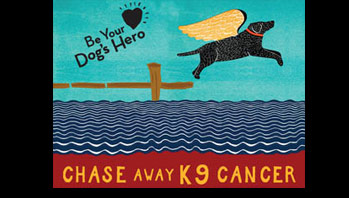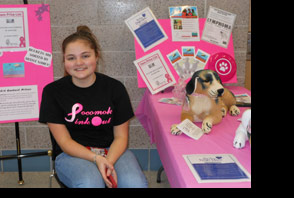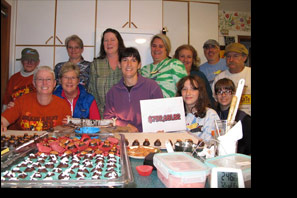 The grants listed below have already been funded with the help of the Chase campaign and demonstrates how each dollar you donate helps. We will provide an update on these studies once they are completed. We are so touched by the generosity of everyone who has supported this campaign.
The grants listed below have already been funded with the help of the Chase campaign and demonstrates how each dollar you donate helps. We will provide an update on these studies once they are completed. We are so touched by the generosity of everyone who has supported this campaign.
Current studies update :
Dr. Trepanned
Thank you so much for your support to date for “Discovering genetic and environmental risk factors for bladder cancer in dogs,” and for sending dogs our way as controls for our study.
We have recruited 100 dogs with bladder cancer (more than our target) and 68 breed-matched controls. We have environmental data and DNA on all dogs to date.
1) We have recruited more than 70 dogs with bladder cancer (which was our target), and have already matched about 25 of them with older dogs of the same sex and breed that have not developed bladder cancer. This matching is very important to help us tease out important risk factors for bladder cancer.
2) All of our dog owners have been very generous in filling out 5-page environmental questionnaires that cover common household and yard chemicals.F From this, we have found an association between bladder cancer and yard chemicals in a preliminary analysis.
3) We have also found a new GST variant that leads to almost complete loss of activity in dogs. This could lead to an inability to break down potential cancer-causing chemicals from the environment. We are analyzing this GST variant and others in dogs with bladder cancer. However, we need to finish the matched control dogs to pursue this discovery.
A GST variant is a change in a GST gene. GST genes are important for defending the body against environmental chemicals that may be damaging.
Here is a have copy of the updated wishlist for healthy dogs below. As a quick refresher, we define “healthy” as any dog over age 11 (or 8 years old for Scotties) with no history of cancer thus far in life, and no history of lower urinary tract signs in the last year. [Great news: we only need 29 more matches to have all our enrolled TCC cases matched!]
We sincerely thank you and the NCCF & Chase Away K9 Cancer for your support and assistance in our study recruitment efforts!
Best wishes,
Ros Luethcke
| Breed | Sex | Number needed |
| Belgian Sheepdog | FS | 1 |
| Chinese Crested | MN | 1 |
| Border Collie | FS | 1 |
| Labradoodle | FS | 1 |
| Husky | FS | 1 |
| Irish Setter | FS | 1 |
| Mixed Breed (weighing ~26 lbs) | FS | 1 |
| Mix Papillon | MN | 1 |
| Papilllon | FS | 2 |
| Peekapoo | MN | 1 |
| German Shorthair Pointer | F | 1 |
| Puli | MN | 1 |
| Shetland Sheepdog | FS | 1 |
| Samoyed | FS | 1 |
| Toy Fox Terrier | MN | 1 |
| Scottish Terrier (>8 yrs old) | FS | 11 |
| Scottish Terrier (>8 yrs old) | MN | 1 |
| West highland white terrier | MN | 1 |
| West highland white terrier | FS | 1 |
______________________________________________________________
More updated 2018 Studies information :
JHK15MN-004, Genetic Mutations Controlling Vascular Disruption of Hemangiosarcoma
Project Title: Discovery and Pathogenic Significance of Chromosome Translocations in Canine Hemangiosarcoma
Principal Investigator: Dr. Jong Hyuk Kim, DVM, Ph.D, University of Minnesota
Sponsors: National Canine Cancer Foundation / Chase Away K9 Cancer fund
Results: Researchers Unveil Genetic Cues Regulating Malignant Vessel Formation of Hemangiosarcoma
Hemangiosarcoma is a common, devastating disease of dogs. Hemangiosarcoma affects tens of thousands of dogs every year, but there are no objective tests to predict the behavior of these tumors or to guide therapy. And in fact, there are no effective treatments for this disease. In general, this tumor consists of abnormal, blood vessel-forming cells that grow into disorganized, vascular tissues.
In this project, the researchers identified novel gene mutations in canine hemangiosarcoma, which can create “fusion genes”. Signals transmitted by these fusion genes likely contribute to the development hemangiosarcoma in dogs, and potentially to the abnormal features of blood vessels in these tumors. The fusion genes themselves are a result of genetic errors where parts of two (or more) different genes that normally reside in different locations or the genome are brought into close proximity. The results from this project showed that, while no two hemangiosarcomas had identical fusion genes, there was a theme involving the types of genes and gene functions that were involved in this process. Additional work will be needed to determine the mechanisms that control the predilection for these genes and pathways.
In ongoing work, the researchers seek to establish how these different fusion genes control the behavior of hemangiosarcoma, including their potential role in therapy resistance. This in turn, will allow us to design more effective treatments to prevent or slow tumor growth and improve survival of dogs with hemangiosarcoma.
______________________________________________________________
November 2014
The Chase away K9 Cancer Fund helps out with $26,000 to partner on this study with the National Canine Cancer Foundation to fund a new innovative Hemangiosarcoma (HSA) Research Project.
I have some new exciting news. As you all know we are always trying to find an new edge in the battle against canine cancer. And Hemangiosarcoma (HSA) is one of those cancers we would like to get a better handle on since it seems to end up being diagnosed too late to save the dog. In fact, we are so keen on finding out how to deal with HSA that we have actually initiated our own research project on HSA with G. Elizabeth Pluhar, D.V.M., Ph.D., and John Ohlfest, Ph.D. This is very exciting for the NCCF because this type of research on HSA has never been tried. Let me tell you how it all came about by first talking about a dog name Batman.
Batman was the first dog to undergo a breakthrough experimental treatment for brain cancer, led by doctors, G. Elizabeth Pluhar, D.V.M., Ph.D., and John Ohlfest, Ph.D. They developed a combination treatment plan for dogs with glioma, a very aggressive and relatively common form of brain cancer. First they removed the tumor surgically. Then, in some cases, they use local gene therapy to attract immune cells to destroy remaining tumor cells, and finally they created a personalized anti-cancer vaccine made from the dog’s own cancer cells to prevent tumor recurrence.
Dr. Pluhar, a surgeon at the Veterinary Medical Center, and Dr. Ohlfest, head of the neurosurgery gene therapy program at the Masonic Cancer Center, gave Batman his initial treatment in August 2008. Batman led a normal life unaffected by his tumor until his death from cardiac failure in February 2010, there was no tumor recurrence. According to the Dean of the College, Trevor Ames, DVM, MS, “the far-reaching implications of this promising new treatment are almost difficult to fathom; not only could these treatments lead to a cure for brain and other systemic cancers in dogs, but because dogs and humans share many physiological traits, dogs could also be the missing link in the cure for brain cancer in humans.”
Then something interesting happened. Almost one year ago, Davis Hawn’s then 8-year-old yellow lab, Booster, was diagnosed with squamous cell carcinoma in his nasal sinus. Booster was given three weeks to live. Hawn did not want to accept the death sentence and began searching the country for a cure. His search led him to doctors in Florida who removed Booster’s tumor and gave him chemo. An online search then led him to Dr. Elizabeth Pluhar from the University of Minnesota’s canine brain tumor clinical program. Davis asked her to help his dog, but Dr. Pluhar had never made a vaccine for this type of cancer before. But Davis was not going to take no for an answer so she did agree to try. She shipped the vaccine off and ten months later Booster is cancer free.
Then after Davis contacted the NCCF to tell us about how well the vaccine works, we contacted Dr. Pluhar to ask if she would be willing to try the same research that was successful with brain cancer and skin cancer, and use the same protocol to try dealing with splenic HSA. The NCCF’s thinking is that with all these other cancers, the similarities were that the cancer had to be removed and a vaccine needed to be created from the cancer cells. With splenic HSA, one of the more common forms of HSA, the spleen is typically removed so we felt that Dr. Pluhar’s research could possibly work. With that in mind, we asked her if she could try and apply her protocol on splenic HSA. After doing some initial research she agreed to do the study based on reaching certain goals before going on to the next level.
First, she needs to insure that we can culture the cancer cells in the lab, Second, she needs to insure that the tumor vaccines stimulate immune cells to attack tumor cells. If she can achieve these two steps she can go on to treat the HSA cancer. We could not be happier and are guardedly optimistic over this research project.
Chase Away K9 Cancer & The National Canine Cancer Foundation are very proud to be joining forces on this $55,500 Grant.
Thank you,
Gary D. Nice
President and Founder NCCF
To date the “Chase Away K9 Cancer” fund has put $55,000 towards this grant in a joint effort with the National Canine Cancer Foundation towards the following grant :
Grant No. DT06PA-001 | Therapeutic inhibition of angiogenesis in canine tumors
Principle Investigator: Andrei Thomas-Tikhonenko, Ph.D.
Chair, Cancer Biology Graduate Program
Chief, Division of Cancer Pathobiology
Department of Pathobiology
University of Pennsylvania
 The National Canine Cancer Foundation has restructered this grant with Dr. Modiano. Instead of one large grant, we are funding the entire study in a series of smaller grants so that we can move the research ahead in a more expedient manner. Listed below are the grants funded and the most recent in the series of grants to be funded.
The National Canine Cancer Foundation has restructered this grant with Dr. Modiano. Instead of one large grant, we are funding the entire study in a series of smaller grants so that we can move the research ahead in a more expedient manner. Listed below are the grants funded and the most recent in the series of grants to be funded.
First in the Series of Grants
Amount of Grant:
$150,000 THIS GRANT HAS BEEN PARTIALLY FUND THROUGH DONATIONS AND SUPPORT FROM OUR SUPPORTORS, THE LANCE MEMORIAL FUND, THE TEXAS SHOOT OUT AND CHASE AWAY K9 CANCER FUND. WE ARE STILL ACTIVELY FUNDRAISING FOR THIS GRANT
Title:
Therapeutic inhibition of angiogenesis in canine tumors.
 Abstract:
Abstract:
During the last decade, human medicine has witnessed the emergence of the new generation of cancer drugs, which were rationally designed to block pathways crucial to tumor growth. One eloquent example is the inhibitors of angiogenesis (the ingrowth of new blood vessels into the tumor). All tumors need a blood supply to provide rapidly dividing cancerous cells with oxygen and nutrients. The task of generating new vessels is two-fold: it requires an increased production of pro-angiogenic molecules and a decreased production of anti-angiogenic molecules. The chief proangiogenic molecule is a protein called VEGF (for Vascular Endothelium Growth Factor.) The chief anti-angiogenic molecule is a protein called TSP (for ThromboSPondin.) That most tumors go to extraordinary lengths to overproduce VEGF and silence TSP attests to the significance of these molecules.
In our proposal we will focus on three complementary Aims.
- To generate canine ÒVEGF trapÓ proteins capable of binding and sequestering this pro-angiogenic factor. This will be achieved by artificially truncating naturally occurring cell membrane-bound form of VEGF sensors (known as VEGF receptors). The truncated forms typically do not possess pro-angiogenic activities. Instead they channel VEGF into dead-end protein-protein interactions.
- To test anti-angiogenic activities of polypeptides based on the canine thrombospondin-1 protein. Experimental tumors will be treated with either polypeptides themselves or DNA fragments encoding such peptides.
- To identify molecules capable of re-activate endogenous (tumor-produced) thrombospondin.
Two classes of molecules are under investigation:
a) compounds that directly increase the half-life of thrombospondin-1 messenger RNA; b) compounds that increase the half-life of the protein called p53, which is the major activator of thrombospondin.
By the end of the 3d year of NCCF-funded research, we expect to have begun clinical trials involving at least some of these newly developed therapeutics. By the very nature of anti-angiogenic compounds, they can be applied towards a wide range of common canine neoplasms ranging from Hemangiosarcoma to breast cancers to B-lymphomas, which collectively account for the majority of cancer-related deaths in dogs.
September 2011 Chase Away K9 Cancer joined the National Canine Cancer Foundation and helped with $14,128 towards this grant that totaled $25,000 with support from the Lance Memorial Fund and the Texas shoot out.
Grant No. DM06CO-002 | Innovative Molecular Targets for Prevention and Treatment of Canine Hemangiosarcoma
Principle Investigator: Jaime F. Modiano, V.M.D., Ph.D.
Perlman Professor of Oncology/Comparative Medicine College of Veterinary Medicine and Masonic Cancer Center University of Minnesota
Title:
Tumor-Environment Interactions in Canine Hemangiosarcoma
Principal Investigators: Leslie Sharkey, DVM, PhD, DACVP and Jaime F. Modiano, VMD, PhD
Abstract:
Canine hemangiosarcoma (a tumor of blood vessel lining cells) represents one of the deadliest cancers that affect dogs. While there is predilection for certain organs such as the spleen, skin and heart, these tumors can arise in any organ, they are highly metastatic, and they are poorly responsive to conventional therapies. The common prevalence and poor response of this tumor have led many groups to test new experimental therapies, including metronomic chemotherapy, various anti-angiogenic strategies, the histone deacetylase inhibitor (DNA modifier) SAHA (vorinostat), immunotherapeutic approaches, protein tyrosine kinase inhibitors, and others. While these approaches have reported anecdotal success, none have shown conclusively that they can produce equal or better responses than the current standard of care (surgery plus cytotoxic chemotherapy).
Our group has devoted considerable resources to understand the etiology of hemangiosarcoma at the cellular and the molecular level, hoping to generate new knowledge that might lead to more successful management of this cancer. Our preliminary results suggest that a specialized cell type that participates in blood vessel formation (hemangioblast) may give rise to the tumors. These cells have the potential to alter their surroundings to maximize their potential for growth and survival. Furthermore, they have certain features that could be responsible for the resistance of these tumors to conventional chemotherapy drugs. These findings have encouraged us to be circumspect about the dogma surrounding hemangiosarcoma. In fact, these tumors are complex tissues, and it is not clear which components within this tissue arise from the malignant population and which components are derived from normal cells recruited into (or responding against) the malignant cells. In fact, it is well established that many tumor lesions are comprised of a mix of malignant and non-malignant origin cells, and that the behavior of the non-malignant origin cells can be pivotal in influencing the biological behavior of neoplastic cells and thus patient prognosis. This raises several important questions regarding the aggressive biological behavior of canine hemangiosarcoma. To begin to answer how the local tissue microenvironment contributes to the biological behavior of canine hemangiosarcoma, we propose to define which components of canine hemangiosarcoma lesions arise from a malignant cell population and which components are derived from normal cells using in vivo models. Increasing evidence suggests that many cancers rely on the activity of normal surrounding tissue to achieve their malignant phenotype, and modification of their environment may influence the biological behavior of the tumor. Once we have a better understanding of the interactions between the malignant hemangiosarcoma cells and the normal supporting microenvironment cells (inflammatory, angiogenic, stromal, and nerves), will we be able to determine how to develop strategies to target microenvironmental factors to improve the therapeutic options for this disease.






